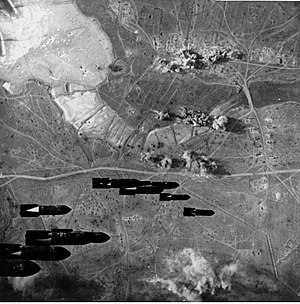
Back Batalla de la península de Kerch Spanish Kertšinniemen taistelu Finnish קרב קרץ' HE Battaglia della penisola di Kerč' Italian ยุทธการที่คาบสมุทรเคียร์ช Thai Trận bán đảo Kerch (1942) Vietnamese
| Battle of the Kerch Peninsula | |||||||
|---|---|---|---|---|---|---|---|
| Part of the Crimean campaign during the Eastern Front of World War II | |||||||
 German bombs fall on the Kerch Peninsula, May 1942 45.260752231734244, 35.46772926230884 | |||||||
| |||||||
| Belligerents | |||||||
|
|
| ||||||
| Commanders and leaders | |||||||
|
|
| ||||||
| Units involved | |||||||
|
|
Caucasus Front[a] Air Force of the Crimean Front Black Sea Fleet | ||||||
| Strength | |||||||
|
8 May 1942: 232,549 men (2 May)[1] 200 tanks[2] 57 assault guns[3] 800+ aircraft[4] 95,000 men (2 May)[1] |
8 May 1942: 249,800 men[5] 238 tanks[6] 404 aircraft (Air Force of the Crimean Front)[4] | ||||||
| Casualties and losses | |||||||
|
38,362 Breakdown
|
570,601 Breakdown
| ||||||
The Battle of the Kerch Peninsula, which commenced with the Soviet Kerch-Feodosia Landing Operation (Russian: Керченско-Феодосийская десантная операция, Kerchensko-Feodosiyskaya desantnaya operatsiya) and ended with the German Operation Bustard Hunt (German: Unternehmen Trappenjagd), was a World War II battle between Erich von Manstein's German and Romanian 11th Army and the Soviet Crimean Front forces in the Kerch Peninsula, in the eastern part of the Crimean Peninsula. It began on 26 December 1941, with an amphibious landing operation by two Soviet armies intended to break the Siege of Sevastopol. Axis forces first contained the Soviet beachhead throughout the winter and interdicted its naval supply lines through aerial bombing. From January through April, the Crimean Front launched repeated offensives against the 11th Army, all of which failed with heavy losses. The Red Army lost 352,000 men in the attacks, while the Axis suffered 24,120 casualties. Superior German artillery firepower was largely responsible for the Soviet debacle.[14]
On 8 May 1942, the Axis struck with great force in a major counteroffensive codenamed Trappenjagd which concluded by around 19 May 1942 with the liquidation of the Soviet defending forces. Manstein used a large concentration of airpower, heavily armed infantry divisions, concentrated artillery bombardments and amphibious assaults to break through the Soviet front in its southern portion in 210 minutes, swing north with the 22nd Panzer Division to encircle the Soviet 51st Army on 10 May and annihilate it on 11 May. The remnants of the 44th and 47th armies were pursued to Kerch, where the last pockets of organized Soviet resistance were eradicated through German aerial and artillery firepower by 19 May. The decisive element in the German victory was the campaign of airstrikes against the Crimean Front by Wolfram von Richthofen's 800 aircraft VIII. Fliegerkorps, which flew an average of 1,500 sorties per day in support of Trappenjagd and constantly attacked Soviet field positions, armored units, troop columns, medical evacuation ships, airfields, and supply lines.[15] German bombers used up to 6,000 canisters of SD-2 anti-personnel cluster munitions to kill masses of fleeing Soviet infantrymen.
Manstein's outnumbered 11th Army suffered 7,588 casualties, while the Crimean Front lost 176,566 men, 258 tanks, 1,133 artillery pieces and 315 aircraft in three armies comprising twenty-one divisions.[16] Total Soviet casualties during the five-month-long battle amounted to 570,000 men, while Axis losses were 38,000. Trappenjagd was one of the battles immediately preceding the German summer offensive (Case Blue). Its successful conclusion allowed the Axis to concentrate their forces on Sevastopol, which was conquered within six weeks. The Kerch Peninsula was used as a launching pad by German forces to cross the Kerch Strait on 2 September 1942 during Operation Blücher II, a part of the German drive to capture the Caucasus oilfields.
Cite error: There are <ref group=lower-alpha> tags or {{efn}} templates on this page, but the references will not show without a {{reflist|group=lower-alpha}} template or {{notelist}} template (see the help page).
- ^ a b Isaev 2016, p. 626.
- ^ Forczyk 2014, p. 168.
- ^ Forczyk 2014, p. 163.
- ^ a b Hooton 2016, p. 116.
- ^ a b Krivosheev 1997, p. 108.
- ^ Isaev 2016, p. 638.
- ^ "Heeresarzt 10-Day Casualty Reports per Army/Army Group, 1941". Archived from the original on 25 May 2013. Retrieved 19 March 2018.
- ^ a b Forczyk 2014, p. 127.
- ^ a b Forczyk 2014, p. 171.
- ^ a b c Forczyk 2008, p. 36.
- ^ a b Hooton 2016, p. 117.
- ^ Krivosheev 1997, p. 122.
- ^ Glantz 2001, p. 165, 115,630 in January, 98,523 in February, 74,125 in March and 63,722 in April.
- ^ Glantz 2001, p. 163.
- ^ Melvin 2010, p. 268.
- ^ Erickson 1975, p. 347.
© MMXXIII Rich X Search. We shall prevail. All rights reserved. Rich X Search